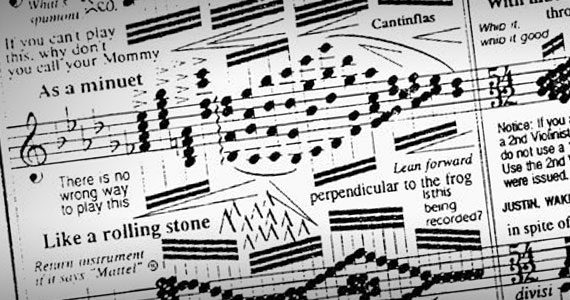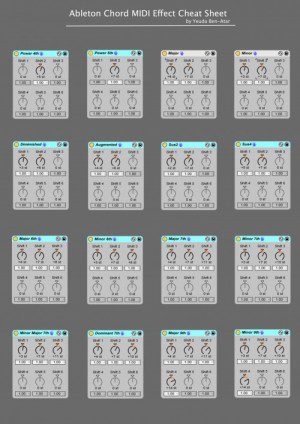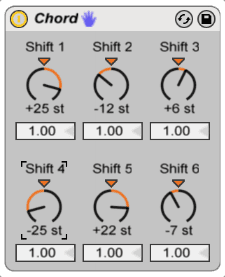Chord MIDI Effect
Live’s Chord MIDI effect is a powerful tool. It lets you play one note and create full chords. The built-in presets are great but don’t cover the full spectrum of basic chords. Download the cheat sheet at the bottom of the page to help you build any type of basic chord with ease, Without knowing any Music Theory. But if we already mentioned Theory, Lets talk about it for a second.
Theory
The Chord MIDI effect have 6 knobs. Each knob can add more notes on top of the note you are playing on your MIDI or Computer Keyboard. The knob values are “st” which stands for Semi-Tones.
Semi-Tones are the way we count the distances between two notes. The Distances are called Intervals.
We give each type of interval a name. For example:
The distance between the C note and the C# note is 1 Semi-Tone and that interval is called Minor 2nd.
So that means that the interval between G and G# is a Minor 2nd and the distance between F and Gb is a Minor 2nd and the distance between E and F is a Minor 2nd and so on.
Intervals
Here is a List of all the Intervals in one Octave (Which is actually also a name of an Interval):
*Remember that “st” stands for Semi-Tones
Unison – 0st
Minor2nd – 1st
Major 2nd – 2st
Minor 3rd – 3st
Major 3rd – 4st
Fourth – 5st
Tritone – 6st
Fifth – 7st
Minor 6th – 8st
Major 6th – 9st
Minor 7th – 10st
Major 7th – 11st
Octave – 12st
Check out this list of examples for the intervals in famous melodies.
Chords
Now lets take a look at a few Chord Formulas:
Major: Root Note, Major 3rd, Fifth
Minor: Root Note, Minor 3rd, Fifth
Diminished: Root Note, Minor 3rd, Tritone
Ok now what? Now using the Interval list and this three chord formulas we can play Major, Minor or Diminished chord on any key.
For example: If we start from the C note. That’s going to be our root note. And lets say we want to play the C Major chord:
– The root note is C
– The Major 3rd is 4 Semi-Tones above C so we will end up on E
– The Fifth is 7 Semi-Tones Above C so we will end up on G
So to play C Major we play the C, E and G notes.
You can repeat this for any type of chord on any key.
“Cheating”
 But what if we don’t care about Music Theory and just want some chords to play around with? We can use the Chord Effect!
But what if we don’t care about Music Theory and just want some chords to play around with? We can use the Chord Effect!
If we want to play all the Major Chords we can set up the first knob to 4st (Major 3rd) and the second knob to 7st (Fifth).
Now every single note I’ll play will be the Root Note of that Major chord.
Check out the Free Download for a Cheat Sheet showing you how to set up the Chord Effect for all types of basic chords.
Bonus Tip: While focusing on one of the knobs of the Chord Effect, Hold Shift and hit the up or down arrow keys to jump the value up or down by an octave. This will give you a different Inversion of the chord.
And remember, If you like a chord save it as a preset!
Check back next week for an insanely huge package of chord presets for download.



Thanks Yueda!
so theres no download.. u have posted a low resolution unreadable version of the cheat sheet..
is there a pdf or png? or something?
At the bottom of the page there is a download button. Or you can go directly here: https://gumroad.com/l/eMMA
Its free oh wait i have to give my credit card info no thanks
Make sure you put 0 in the amount. No credit card needed
You offer a free download but require credit card info? ummm i think not
You can put 0 in the amount and you won’t need to put your card info.
The download appears to require a payment and there is no download for free option. Can you show us how to download for free or change the title of the page?
If you out 0 in the amount you won’t need to put your card info.
finally found what I was looking for! Thank you thank you !!
lol. how dumb are peole.. put 0 in and no credit card info needed.. i m really concerned for the human race after reading the comments..
Maybe it was simply not obvious and down to the design of gumroad.
Great display of ignorance, go and troll some other people’s constructive comments.
Guys, The gumroad deal was not clear and I apologize. Again, You can put 0 for the amount and you don’t need to put your CC details.
I hope you guys like the stuff on the website.
Cheers.
This is rad! Thank you sooooo much, was just looking around online today for a piece of hardware that can do these effects and here we be! Ableton rules the world again! Thanks so much!
Thank for the free download bro
thanks for sharing this :)
I have to think that you are doing this for the love of art of music, you remain your calm even when people doesnt get it and attack you. Nice guy
Thank you for this
thank you!!
Fantastic. Also thanks for the easy-to-understand write up on theory.
thank you for sharing this..
You’re Welcome Pancha!
Thank you this is great.
Sorry you have to deal with all the little kids that can’t read or put zero in a box to download. Makes music producers look like a bunch of idiots.
Can’t wait for the chord presets.